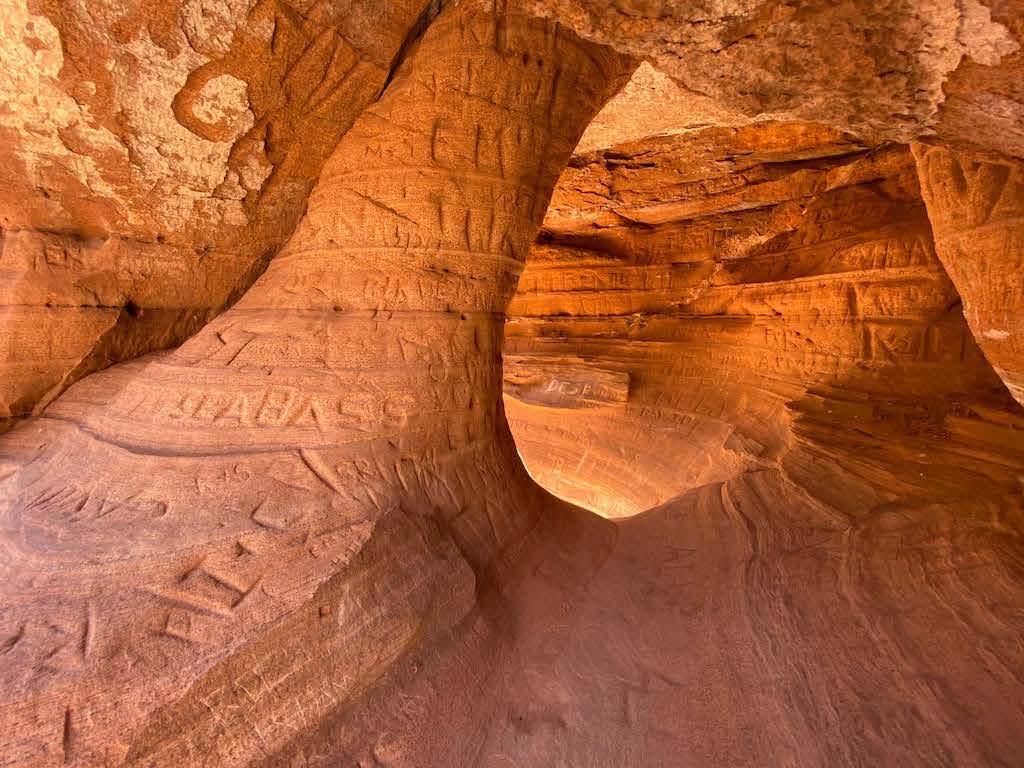
Graffiti continues to be a problem at Zion National Park/NPS
Editor's note: This updates with additional comments from Zion National Park staff.
There are places in the National Park System where carvings, etchings, and even 19th century “graffiti” are preserved. Places like El Morro National Monument in New Mexico, Arches National Park in Utah when you consider pictographs, and Petroglyph National Monument in New Mexico.
Unfortunately, there is a surprising number of 21st century individuals who think it’s perfectly appropriate to carve their names, initials, and other signs and symbols into national park landscapes.
Perhaps the most infamous case in recent years was that of a New York City woman who went through at least seven Western national parks in 2014 and, using acrylic paints and markers, painted and drew images on rocks and cliff faces. Casey Nocket, who promoted her “work” on Instagram, eventually was tracked down, charged, and pleaded guilty to defacing government property. She was sentenced to two years’ probation and 200 hours of community service.
And she was banned from all lands administered by the National Park Service, U.S. Forest Service, Bureau of Land Management, and Army Corps of Engineers during her probation period.
Nocket isn’t alone when it comes to defacing the parks. In recent years problems with graffiti have surfaced at Great Smoky Mountains National Park, Joshua Tree National Park, Grand Teton National Park, Glen Canyon National Recreation Area, Chesapeake and Ohio Canal National Historical Park, and Colorado National Monument, among other sites.
Graffiti with paint is one thing, carving your name or initials into sandstone is something entirely different.
At Zion National Park in Utah, graffiti seems to be an ongoing battle. So much has been surfacing that park officials are urging the public not to leave their “mark” during their visit to the park.
Amanda Dworak Rowland, the park's spokesperson, said Zion staff constantly encourage visitors to follow Leave No Trace practices when exploring the scenic park.
"Our park website and social media outlets provide more information about Leave No Trace as well," she said in an email Friday. "There is also information and messaging shared throughout the Park Service about how across the Colorado Plateau, American Indians, settlers, and cowboys all left signs of their presence. These marks are part of regional history, dating back more than 1,000 years.
"But the world is a different place now: there are more people and more choices in how we express ourselves. Writing on the walls isn’t necessary, and in a national park, it’s illegal. This is a growing problem facing many national parks, as you may have seen in recent news stories. We are encouraging visitors to take only photographs and leave only footprints."
According to a park release, nearly every day "staff find words and shapes, carved, drawn, painted (with mud, dirt, pigment, paint), or scratched on rocks and more recently even carved within moss. Over four million people visit Zion every year. Please allow other park visitors their opportunity for discovery, by leaving rocks, plants, archaeological artifacts, and other objects as you found them.”

Sometimes the Zion National Park vandals use paint...

...sometimes they scratch away at sandstone...

...and sometimes they resort to living trees to leave their mark./NPS photos
“Not only is graffiti unsightly and damaging to the surface defaced, but removing it takes time, money, and staff to do so,” added the release. “Depending on the area damaged and what the surface is, it can take park staff hours to remove using a variety of equipment that has to be carried to the site. Graffiti and other forms of damage to park resources are harmful and illegal. Repair of vandalized sites is costly and time consuming. Often, a damaged site can never be fully restored to its original condition.”






Comments
I took pictures of Casey Nockets paintings on rocks in Rocky Mountain National Park- she even signed them in paint. She considered herself a creative artist ! Wonder if Community Service changed her mentality.
Additional Signage and Education
Increased Oversite
Stiffer Penalties
My wife and I have been full time retired rv travelers for 4 years and we have found state,federal, National, city or local parks of all kinds have been trashed or defaced in some way. It's time to stop the pampering the violators and start digging into their pocket books. Some may need some jail time. As tax payers that follow the rules and help take care of all parks we sre getting tired of cleaning up a camp site and trails that we paid to use because someone decided it would be fun to trash and damage our parks. We have spoke with many campers that feel the same way.
Folks need to address those doing the damage when they are caught in the act. Direct peer pressure can be powerful, but has risks.
Great article, Kurt Repansher. I teach a course on the History of National Parks (US and world-wide) at Eastern Washington University, and graffiti in the parks is one of the many topics we explore. I have a blog post, borrowing on my course material, where I just published one of my "Fireside Talks" on graffiti in National Parks "and elsewhere" including examples from Fort Larned in Kansas, and the Old City in Jerusalem -- crusader graffiti! On the chance that you or anyone else might be interested here's the URL for that blog post: In the mean time, I'm posting an announcement tonight to the class suggesting they check out your article.
http://www.americanrealities.com